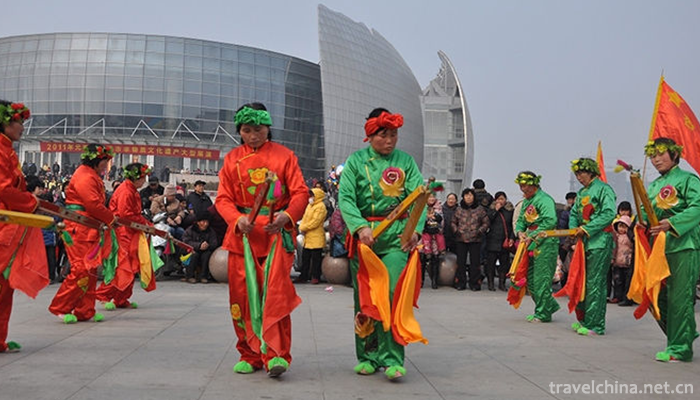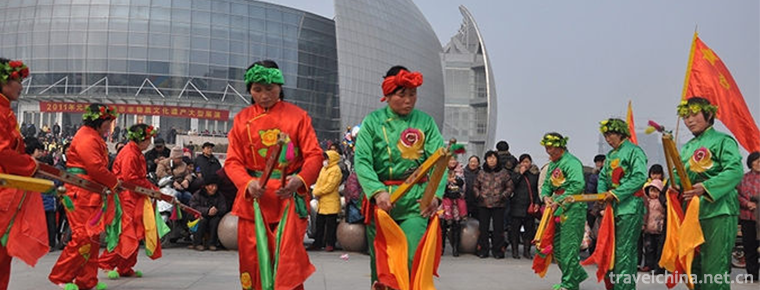Shangyang Dance
Shangyang Dance
Shangyang Dance, a traditional folk dance in Juancheng County, Shandong Province, is one of the national intangible cultural heritage.
Shangyang Dance originated in the northern part of Juancheng County and spread around Li Jinshitang Town and Old Town. It is represented by Xinggrang Village of Li Jinshitang Town. According to textual research, this dance originated in Shang and Zhou Dynasties, matured in the Spring and Autumn Period and the Warring States Period, and flourished in the Song and Ming Dynasties.
On June 7, 2008, Shangyang Dance was approved by the State Council of the People's Republic of China to be included in the second batch of national intangible cultural heritage list, the heritage number: III-49.
historical origin
"Shangyang Dance" is a kind of ancient sacrificial folk dance, which spreads around Xinggrang Village, Jiuyu Township, Juancheng County, Heze City. Juanyi in the Spring and Autumn Period was located on the Bank of the Yellow River in the contemporary era. By the Warring States Period, Juanyi was already a very prosperous city. According to "Puzhou Zhi. Historic Site", it said: "There are apricot granites in the three miles northeast of the old city." Is one of the eight scenic spots in Puzhou, "Xinggang spring red ten miles, night to listen to Gulin hit the evening bell" origin. The "Shang Yang Dance", which originated from the ancient apricot granite, continued after thousands of years.
The written record of Shang Yang Dance was first found in Confucius Jiayu. Documentation: "Qi has enough birds, flying in the Gong Dynasty, down to the front of the palace, jumping with ease of wings, Qi Hou weird. When he hired Lu to confucius, Confucius said, "This bird is called Shang Yang, and the water sample is also like this." It's raining heavily and the merchant sheep are encouraged. Now it's all there. It's time to call on the people urgently. There will be floods and heavy rains on hectares, flooding all countries and hurting the people. Only when we are ready and invincible can we build dikes and ditches.
Pu Songling in the Qing Dynasty also described the Shang Yang Dance in his "Dancing God" chapter of "Strange Tales from a Liaozhai Studio": "Women wear short skirts to make Shang Yang Dance." At the end of the Qing Dynasty, Jinan and Beijing invited witches to be God dancers, all of them succeeded in "Shangyang Dance". The primitive and simple "Shangyang Dance" adds some mystery to it because of the wizard's use in dancing to catch ghosts and gods.
In 1956, four literary and artistic workers from the Political Department of the Beijing Military Region came to Juancheng to rehearse the Shang Yang Dance with the artists who danced the Shang Yang Dance. These four artists repeatedly told the dancers that the Shang Yang Dance was an endangered ancient dance, and only the apricot granite remained in China, hoping to attract attention and be passed down from generation to generation. In the same year, Zhao Zilin, a dancing beauty worker in the county cultural hall, excavated and sorted out the Shang Yang Dance and moved it to the art stage to participate in the folk dance concert in Shandong Province.
In January 2005, the Chinese Opera Research Institute and some experts and professors from the Music Department of Shandong Normal University attended the performance of Shangyang Dance in Xinggrang. In contemporary times, Shang Yang Dance is again active among the people in Juancheng, sometimes performing simultaneously with such folk art forms as stilts, floats, early boats, dragon and lion dances.
In April 2007, Juancheng County Bureau of Culture and Sports appointed a special person to discuss with the old artists in Xinggrang, recorded the Shangyang Dance in writing and recorded the video, and made a careful register of the genealogical inheritors of the dance.
Inheritance and Protection
Inheritance value
Shang Yang Dance is a folk dance with local and folk characteristics. It is deeply rooted in rural folklore. For thousands of years, it has been an art form loved by the working people and a "local treasure" in the treasure house of Chinese traditional culture. It is a prominent manifestation of Juancheng people's traditional culture. It contains the spirit of expectation, belief, value orientation, and involves all aspects of Juancheng Festival customs. It has the special value of Anthropology and folklore research materials, and has attracted the attention of Chinese and foreign academic circles.
Heritage figures
Chen Yuying, female, the representative successor of the fifth batch of national intangible cultural heritage projects (Shangyang Dance), was declared by Juancheng County, Shandong Province.
protective measures
In 1956, after the excavation and arrangement of Zhao Zilin, an old artist, Shangyang Dance was put on the cultural stage.
In 1990, Shangyang Dance was included in the Folk Dance Chapter of the Great Dictionary of Chinese Folk Art.
In October 1995, Juancheng County Culture and Sports Bureau and Radio and Television Bureau jointly reorganized and restored Shangyang Dance, started to select and train new people, and recorded the "Shangyang Dance" CD-ROM.
In 2006, Shangyang Dance was listed in Shandong intangible cultural heritage list by the State Council of the People's Republic of China.
In August 2014, the Dance Academy of Shandong Art Academy "Research Shandong" team went to Heze Juancheng County to carry out a field research entitled "Feasibility Investigation of Shandong intangible cultural heritage dance into classroom - Take Shangyang Dance in Juancheng County as an example".
social influence
On September 14, 2018, Shang Yang Dance, which was promoted by Juancheng County, appeared as the only folk dance selected by Heze in the performance of Beijing National Theatre, demonstrating Juancheng culture and characteristics of folk dance.
On September 25, 2018, Shang Yang Dance was displayed in Heze Peasant Games and Juancheng First Peasant Games, which celebrated the "Chinese Peasant Harvest Festival".


-
1.Ruoergai CountyZoige County
Zoige County is located in the northeastern edge of the Qinghai-Tibet Plateau
Time 2018-10-12 -
2.Shuanglang
located in the northeast of Dali City and the northeast coast of Erhai Lake
Time 2018-10-17 -
3.Mixed Congee
Eight treasures, also known as Laba porridge, porridge, Chinese traditional festival food. It is a gruel made from a variety of ingredients in Laba. Chinese scholars in the Southern Song Dynasty
Time 2018-11-02 -
4.Soup with pepper
Soup with pepper, a well-known snack in Central Plains, originated in Xiaoyao Town, Xihua County, Zhoukou City, Henan Province, and Beiwudu Town, Wuyang County, Luohe City. Especially known as Xiaoyao
Time 2018-11-10 -
5.Baishuizhai Scenic Area
Baishuizhai Scenic Spot is located in Paitan Town, Zengcheng District, with an area of about 170 meters. The Tropic of Cancer passes through it. It is known as the magnificent Emerald on the Tropic
Time 2019-01-02 -
6.Zhangye Great Buddhist Temple
The Great Buddha Temple was built in the first year of Yongan, Xia Dynasty (1098), formerly known as the Kaye Tathagata Temple, in the ninth year of Yongle, Ming Dynasty (1411), and in the seventeenth
Time 2019-03-16 -
7.Enshi dulcimer
Enshi Yangqin, also known as Enshi Silk String, was made up of Hunan Opera, Southern Opera, Chu Tune, folk minor, instrumental music licensing scholars and
Time 2019-04-28 -
8.Handmade Weaving Techniques of Wood Machine Cosmetics
Nanjing Yunjin wooden machine makeup and hand-weaving skills, the local traditional skills of Nanjing, Jiangsu Province, one of the national intangible cultural heritage.
Time 2019-06-07 -
9.Shuizu Duanwu Jie
The aquarium duanjie is called "borrowing duanjie" in the language of water. "Duan" means "the first year of life" or "New Year", "borrow" means "
Time 2019-06-16 -
10.Bronze Ware Making Skills Datong Copper Ware Making Skills
Datong bronze ware is a traditional handicraft of the Han nationality. It has a long history and exquisite craftsmanship. As early as the Northern Wei Dynasty, it enjoyed a great reputation. Since the
Time 2019-06-21 -
11.Xiabaoping Folk Stories
There are many original ecological works of Xiabaoping folk tales, which have distinct local characteristics and high cultural taste. It is the epitome of the traditional folk literature in the Three
Time 2019-07-01 -
12.Western Grand Canyon
Synonyms Western Grand Canyon hot spring generally refers to the Western Grand Canyon
Time 2020-10-16